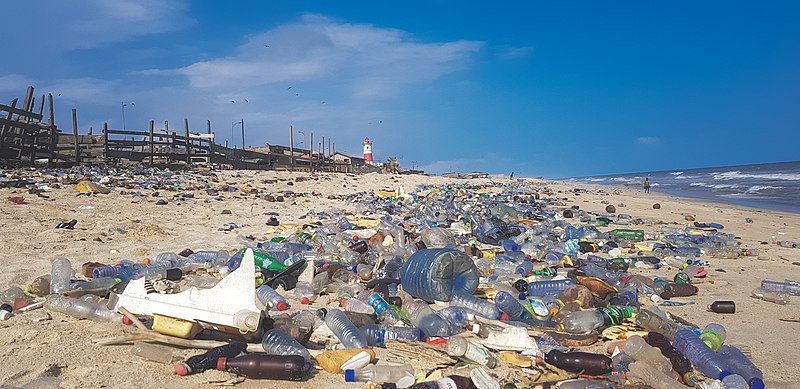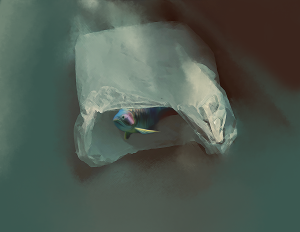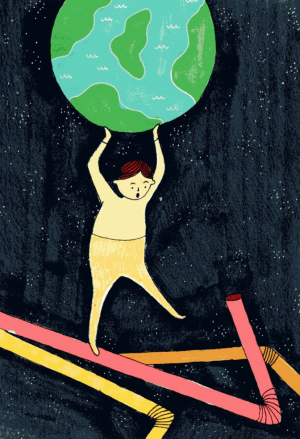The plastic pollution pandemic
Wikimedia Commons
Plastic lines many of California’s beaches, devastating both the land and seas around it.
September 13, 2022
While the COVID-19 pandemic has taken over our lives, another more subtle pandemic is growing: the plastic pandemic. The pandemic has increased usage of sanitary plastic products, which are being washed into our oceans and are directly affecting the environment, as well as humans.
As industries produce plastic to keep up with the demands of masks, gloves and other products of the pandemic, the waste that is left behind accumulates in the environment.
“What we’ve heard from [our] local volunteers is that the amount of single-use plastic packaging that they’re finding in their communities has increased,” Eben Schwartz, the Marine Debris Program Manager for the California Coastal Commission said. “We are just seeing a lot of gloves and masks out in the environment.”
An estimated 129 billion masks are being used and thrown out every month.
“I think when [people] become aware of just how much plastic enters the environment every year, and the role that they could play in that, they [are] self motivated to get involved,” Schwartz said.
8 million metric tons of plastic enters the world’s oceans every single year; and almost all of that is plastic packaging. It’s all stuff we use every single day, whether that’s single-use plastic water bottles or plastic grocery bags. An estimated 30% more pandemic-related plastic waste is being washed into our oceans.
“And we’ve seen a whole mess of to-go containers,” said Lynn Adams, President of the Pacific Beach Coalition. “It’s been pretty rough with everybody outside leaving [trash] all over the place.”
Because greater amounts of waste are being left on our streets, people are beginning to realize just how much plastic our world is infested with.
“We’ve had a lot of people come to us [this year] and say ‘What can we do?’, ‘How can we help?’,” said Adams, “People have been stuck at home, and they started walking [around] in their neighborhoods and seeing all this litter and saying, ‘This is not okay’.”
The Pacific Beach Coalition recently started a program called Street to Beach cleanup events, where students can get community service hours by participating and cleaning up their local neighborhoods.
“We ended up getting a lot of volunteers that are picking up [plastic] on the streets around their houses, their favorite park and their favorite neighborhood walk,” said Adams.
If people went out and did pickups, they would realize just how much plastic is left behind. The firsthand experience makes them realize that maybe it’s time to start being more careful.
Plastic pollution not only infects the environment, but can have a harmful effect on human beings as well.
If you’ve ever eaten any seafood, chances are, you’ve eaten plastic.
Plastic is found everywhere in our oceans. It takes plastics around 450 years to fully decompose in the ocean, while on land, it can vary between 50-200 years. As these plastics get smaller and smaller over time, many ocean organisms consume the microplastics– and inevitably, we consume it, too.
“I think the most horrifying part is the idea that these things are ending up in the food that we eat, and having potential impacts on human health, not just the health of marine animals,” Schwartz said.
Biomagnification describes the amount of toxin that accumulates in your body over time, as you consume more and more organisms that have ingested microplastics. As humans occupy the top of the food chain, the plastics we consume have a magnified effect on our bodies.
“There’s a whole host of different chemical responses that we’re starting to see from animals ingesting plastic that we don’t even have good science on yet, but we know that it’s pretty bad.” said Schwartz.
Plastic has devastating effects on marine organisms of all kinds, and humans are at fault. Over 1 million seabirds and 100,000 marine mammals are being killed due to plastic entanglement or consumption every year.
“I think it’s important for us to think about adaptation versus mitigation,” Annie Nguyen, an Environmental Science teacher at Dougherty Valley, said. “Adaptation refers to living with the problem. So, accepting that there’s a bunch of plastic that’s already in the ocean, and trying to remove it, versus mitigation, which is… how do we reduce the plastic that gets out there in the first place?”
But we can’t get rid of plastic so easily from our lives. Every time you do laundry, plastic fibers from your clothes get flushed into the ocean. Around 73% of fish caught in mid-ocean depths in the Atlantic Ocean were found to have plastic fibers and microplastics found in their stomachs.
The solution to plastic fibers in your clothes might seem simple– just buy natural fibers or fewer clothes overall– but it’s much more complicated. Simply washing your clothes only when necessary is a small step, but buying environmentally friendly clothing is a luxury only some can afford.
As consumers, we have the responsibility to make our own decisions. If you have the means to buy a metal water bottle or use reusable grocery bags, it not only benefits yourself, but our entire world.
“[But] over time, we’re starting to see that it should be less about the consumer making these choices in their everyday life, and more about businesses and corporations not even making the plastic available in the first place,” Nguyen said.
Businesses and corporations opt to produce plastic because it’s cheap and very profitable. About 380 million tons of plastic are produced each year, contributing almost 600 billion dollars to the plastic industry in the U.S. in 2020. And now it’s our jobs as citizens to clean up the mess the producers have made in our environments.
“We have to go to the producer; we have to hold them accountable for the cost of our climate,” Adams said.
Plastic production is also a big contributor to global warming and climate change. 99% of all plastics are made out of fossil fuels. As the plastic economy continues to grow, it’s projected that the production could cause global temperatures to rise up to 1.5 degrees Celsius itself. Then there’s the transportation and shipping of plastics, which release even more carbon dioxide into the air.
The plastic that flows into the ocean is expected to triple in size in the next 20 years. While this seems overwhelming, you can still make a difference, no matter how small.
Beach cleanup programs from the California Coastal Commission like Coastal Cleanup Day and Adopt-A-Beach are a great way to start.
Our actions over the next 10 years will determine the state of our oceans for millennials to come.
If we can keep this plastic problem in the back of our minds, nagging at us everytime we reach for a plastic bag at the grocery store or buy plastic products, we can make a big difference. It’s never too late to change the way you perceive this problem: a crisis we are able to make better.
“It’s a challenge we have to take. We have to stop the flow. We have to change to something else.” said Adams.





